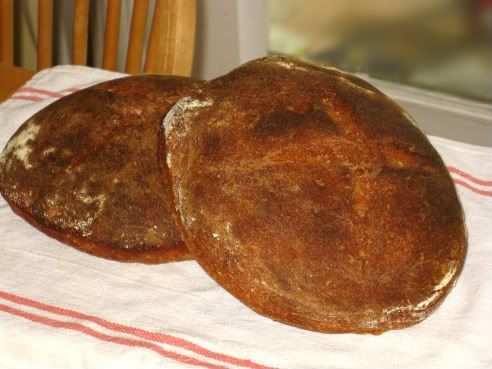Playing with sourdough starters, I knew at some point I wanted to try making Vermont Sourdough. Well, actually, I was planning on making Susan's adaption, Norwich Sourdough, over at Wild Yeast. However, I wound up making a 125% hydration sourdough starter instead of her 100% hydration starter, so I just went with the original. Next time it'll be Norwich Sourdough.
This was a far easier bread to make than I had originally thought. I used 2 tbs of my 200% hydration starter and fed it as a 125% hydration starter. After a few feedings it was fine, bubbling away nicely.
One if the things I learned from making this recipe, and I am a slooooooow learner it seems, is to use smaller amounts of my 100% Rye culture, "George" when growing a specific starter. I've been using 1/2 cups of it, and then not being able to figure out why it's speeding through the feeds so quickly.
I discovered (yes, I am slow) that if I use a smaller amount of the wild yeast culture (2 tbs instead of the 1/2 cup) and make up the difference in fresh water and flour, it matures more slowly. This way I don't have to feed it three times a day and it comes to maturity in the morning when I need it instead of 4:30am when I'm sleeping.
I didn't use a steam tray, mixer or baking stone. There are directions for using those in this recipe all over the web.
Vermont Sourdough
Bread by Jeffery Hamelman
makes 2 largish boules
334 grams mature starter (OR
170 grams bread flour
136 grams water
28 grams mature 125% hydration culture
mixed together 12 to 16 hours before making the dough, cover and let stand.)5 1/2 cups flour (680.39 grams)
7/8 cup whole rye flour (90.72 grams)
1 7/8 cup water (419.57 grams)
1 tbs salt (17.01 grams)
When your starter is mature, mix all the ingredients EXCEPT THE SALT in a large bowl.
Let sit for 20 to 60 minutes to autolyse (let the water absorb the flour).
Add the salt and mix for a few minutes until incorporated.
Ferment for 150 minutes in the bowl, stretching and folding at 50 and 100 minutes.
When done, divide into two equal pieces and shape into balls.
Place in proofing baskets or wherever you are proofing the dough and let rise 2 to 2 1/2 hours.
Preheat oven to 475F.
Line baking sheet with parchment paper, spray paper with water.
Turn dough out onto baking sheet and slash with knife (I have difficulty slashing mine).
Mist dough with water and place into oven. Immediately reduce oven temp to 450F and bake for 15 minutes.
After 15 minutes, check crust for colour - if it's too dark, reduce temp. Continue to bake, checking every 15 minutes for colour if baking at 450F, for 25 to 30 minutes. If unsure of doneness, bake a little longer.
NOTE:
I don't know why my loaves don't rise as high as other's do, but they taste good anyway.
Submitting to yeastspotting. :)


No comments:
Post a Comment